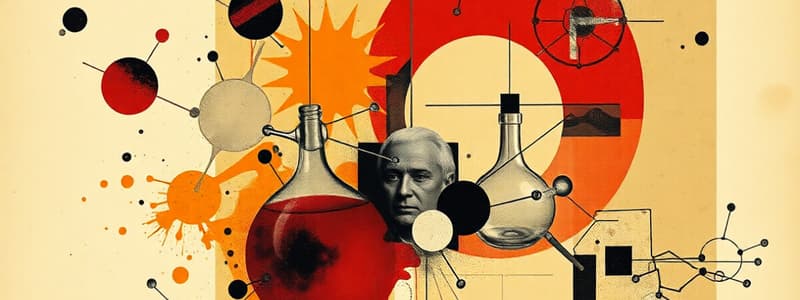Podcast
Questions and Answers
Which substituent decreases the basicity of aniline the most?
Which substituent decreases the basicity of aniline the most?
- -Cl
- -NO2 (correct)
- -NH2
- -OCH3
What is the pKa values order for the strongest basicity in aniline derivatives?
What is the pKa values order for the strongest basicity in aniline derivatives?
- -NH2 > -OCH3 > -CH3 > -H
- -NH2 > -OCH3 > -CH3 > -NO2 (correct)
- -NH2 > -CH3 > -OCH3 > -Cl
- -OCH3 > -NH2 > -H > -NO2
What is the structure of sulphanilamide derived from?
What is the structure of sulphanilamide derived from?
- Acetanilide
- Amine derivatives
- Sulfanilic acid (correct)
- Chlorosulfonic acid
Which of the following groups is activating when attached to an arylamine?
Which of the following groups is activating when attached to an arylamine?
Which is the characteristic feature of arylamines compared to alkylamines?
Which is the characteristic feature of arylamines compared to alkylamines?
Which substituent has a pKa indicating it is a weak base?
Which substituent has a pKa indicating it is a weak base?
Which of these substituents is considered deactivating in aniline?
Which of these substituents is considered deactivating in aniline?
What role does acetanilide play in the synthesis of sulpha drugs?
What role does acetanilide play in the synthesis of sulpha drugs?
What is the primary function of Sennoside A?
What is the primary function of Sennoside A?
Which compound is most abundant in coal tar?
Which compound is most abundant in coal tar?
What type of glycoside is Sennoside?
What type of glycoside is Sennoside?
Which of the following structures is involved in Doxorubicin?
Which of the following structures is involved in Doxorubicin?
What is a significant characteristic of sulphanilamide?
What is a significant characteristic of sulphanilamide?
What type of hydrocarbons are derived from coal tar?
What type of hydrocarbons are derived from coal tar?
Which anthracene glycoside is known for its anti-cancer properties?
Which anthracene glycoside is known for its anti-cancer properties?
What is the aglycone component of Rhein-8-O-glucoside?
What is the aglycone component of Rhein-8-O-glucoside?
Which of the following statements about aniline is true?
Which of the following statements about aniline is true?
What best explains why arylamines like aniline are less basic than alkyl amines?
What best explains why arylamines like aniline are less basic than alkyl amines?
What is the pKa value of the anilinium ion?
What is the pKa value of the anilinium ion?
When aniline is protonated, how does its resonance change?
When aniline is protonated, how does its resonance change?
Which of the following compounds is an example of a tertiary amine?
Which of the following compounds is an example of a tertiary amine?
The basicity of aniline compared to alkyl amines is primarily attributed to which of the following?
The basicity of aniline compared to alkyl amines is primarily attributed to which of the following?
Aniline has a higher boiling point than non-polar compounds of similar molecular weight because it can:
Aniline has a higher boiling point than non-polar compounds of similar molecular weight because it can:
What role does resonance play in the stability of arylamines like aniline?
What role does resonance play in the stability of arylamines like aniline?
How do electron donating and withdrawing substituents affect the basicity of aniline?
How do electron donating and withdrawing substituents affect the basicity of aniline?
What is the significance of the pKa values for understanding the basicity of aniline derivatives?
What is the significance of the pKa values for understanding the basicity of aniline derivatives?
What role does resonance play in the stability of arylamines compared to alkylamines?
What role does resonance play in the stability of arylamines compared to alkylamines?
Describe the relationship between acetanilide and sulphanilamide in the context of sulpha drug synthesis.
Describe the relationship between acetanilide and sulphanilamide in the context of sulpha drug synthesis.
Identify two groups that are considered activating substituents for aniline and their impact on basicity.
Identify two groups that are considered activating substituents for aniline and their impact on basicity.
What is the effect of the -NO2 substituent on the basicity of aniline and why?
What is the effect of the -NO2 substituent on the basicity of aniline and why?
Explain why -Cl is considered a deactivating substituent in aniline derivatives.
Explain why -Cl is considered a deactivating substituent in aniline derivatives.
How does the structure of arylamines influence their basicity compared to alkylamines?
How does the structure of arylamines influence their basicity compared to alkylamines?
What type of compound is aniline and how is it structurally defined?
What type of compound is aniline and how is it structurally defined?
Explain why aniline's basicity is lower compared to alkyl amines.
Explain why aniline's basicity is lower compared to alkyl amines.
What is the boiling point of aniline and why is it higher than that of non-polar compounds with similar molecular weight?
What is the boiling point of aniline and why is it higher than that of non-polar compounds with similar molecular weight?
Discuss the resonance structures of aniline and their impact on its stability.
Discuss the resonance structures of aniline and their impact on its stability.
Describe the solubility of aniline in water and the reason behind it.
Describe the solubility of aniline in water and the reason behind it.
How do primary, secondary, and tertiary amines differ in terms of their general formula?
How do primary, secondary, and tertiary amines differ in terms of their general formula?
What does the pKa of anilinium ion tell us about its acidity compared to methylammonium ion?
What does the pKa of anilinium ion tell us about its acidity compared to methylammonium ion?
What effect does protonation have on the free energy difference between protonated and non-protonated forms of arylamines?
What effect does protonation have on the free energy difference between protonated and non-protonated forms of arylamines?
What is the structural difference between sulphanilamide and substituted sulphanilamide?
What is the structural difference between sulphanilamide and substituted sulphanilamide?
Describe the separation process of an amine from a neutral compound using ether and aqueous layers.
Describe the separation process of an amine from a neutral compound using ether and aqueous layers.
What is the primary use of Sennoside A, and how does it function?
What is the primary use of Sennoside A, and how does it function?
What class of compounds do anthracene glycosides belong to, and can you name an example?
What class of compounds do anthracene glycosides belong to, and can you name an example?
How is Doxorubicin related to anthraquinone, and what is its therapeutic application?
How is Doxorubicin related to anthraquinone, and what is its therapeutic application?
Identify one primary source of polynuclear aromatic hydrocarbons and name two examples.
Identify one primary source of polynuclear aromatic hydrocarbons and name two examples.
What is the significance of anthraquinone glycosides, and why is Rhein notably mentioned?
What is the significance of anthraquinone glycosides, and why is Rhein notably mentioned?
Explain the importance of the ether layer in the isolation of an amine.
Explain the importance of the ether layer in the isolation of an amine.
Flashcards
Antimicrobial agent
Antimicrobial agent
A substance that kills or inhibits the growth of microorganisms, such as bacteria, fungi, or viruses.
Polynuclear Aromatic Hydrocarbons (PAHs)
Polynuclear Aromatic Hydrocarbons (PAHs)
Organic compounds consisting of multiple fused aromatic rings, commonly found in coal tar.
Naphthalene
Naphthalene
A common PAH, one of the main constituents of coal tar.
Anthracene glycosides
Anthracene glycosides
Signup and view all the flashcards
Sennoside
Sennoside
Signup and view all the flashcards
Doxorubicin
Doxorubicin
Signup and view all the flashcards
Anthraquinone
Anthraquinone
Signup and view all the flashcards
Isolation of an amine
Isolation of an amine
Signup and view all the flashcards
Aniline structure
Aniline structure
Signup and view all the flashcards
Aniline basicity
Aniline basicity
Signup and view all the flashcards
Aniline pKa
Aniline pKa
Signup and view all the flashcards
Resonance stabilization (aniline)
Resonance stabilization (aniline)
Signup and view all the flashcards
Aniline physical properties
Aniline physical properties
Signup and view all the flashcards
Aryl amine
Aryl amine
Signup and view all the flashcards
Aniline's intermolecular forces
Aniline's intermolecular forces
Signup and view all the flashcards
Aniline's low basicity
Aniline's low basicity
Signup and view all the flashcards
Arylamine Stability
Arylamine Stability
Signup and view all the flashcards
Electron-Donating Groups
Electron-Donating Groups
Signup and view all the flashcards
Electron-Withdrawing Groups
Electron-Withdrawing Groups
Signup and view all the flashcards
Sulphonamide Antibiotics
Sulphonamide Antibiotics
Signup and view all the flashcards
p-Acetamidobenzenesulfonylchloride
p-Acetamidobenzenesulfonylchloride
Signup and view all the flashcards
Sulphanilamide
Sulphanilamide
Signup and view all the flashcards
Sulphonic Acid
Sulphonic Acid
Signup and view all the flashcards
Amide
Amide
Signup and view all the flashcards
Aniline
Aniline
Signup and view all the flashcards
Aniline's Resonance Structures
Aniline's Resonance Structures
Signup and view all the flashcards
Sulpha Drugs Synthesis
Sulpha Drugs Synthesis
Signup and view all the flashcards
Anthracene
Anthracene
Signup and view all the flashcards
Phenanthrene
Phenanthrene
Signup and view all the flashcards
Primary Amines
Primary Amines
Signup and view all the flashcards
Alkylamine vs. Arylamine
Alkylamine vs. Arylamine
Signup and view all the flashcards
Sulphanilamide structure
Sulphanilamide structure
Signup and view all the flashcards
Sulphanilamide function
Sulphanilamide function
Signup and view all the flashcards
Substituted sulphanilamides
Substituted sulphanilamides
Signup and view all the flashcards
Anthraquinone glycosides
Anthraquinone glycosides
Signup and view all the flashcards
Study Notes
Lecture 5: Chemistry of Aromatic Compounds
- Lecture Content: Aniline, purification of amines, synthesis of sulpha drugs from aniline, naphthalene, anthracene, and phenanthrene.
Aniline (Aminobenzene)
- General Formula: An amine has the general formula: RNH2 (primary amine), R2NH (secondary amine), or R3N (tertiary amine).
- R Group: Where R = alkyl or aryl group.
- Example: CH3NH2, (CH3)2NH, (CH3)3N.
- Definition: When an amino group (-NH2) is directly attached to the benzene ring, the compound is known as aniline.
Aniline: Physical Properties
- Basic Compound: Aniline is a basic compound (Ka = 4.2 x 10-10).
- Polar Compound: Aniline is a polar compound that forms intermolecular hydrogen bonds.
- Boiling Point: Aniline has a higher boiling point (184°C) than non-polar compounds of similar molecular weight.
- Solubility: Aniline forms hydrogen bonds with water, explaining its solubility in water (3.7g/100g water).
Basicity of Aniline
- Less Basic than Alkyl Amines: Arylamines are less basic than alkyl amines.
- pKa Value: The pKa of the anilinium ion is 4.63, while the methylammonium ion has a pKa of 10.66.
- Delocalization: Arylamines (like aniline) are less basic due to the nitrogen's lone pair electrons being delocalized by interaction with the aromatic ring π electron system. This makes them less available to bond with H+.
- Resonance Stabilization: Arylamines are stabilized compared to alkylamines due to resonance structures.
- Protonation: Resonance stabilization is lost during protonation, as only two resonance structures are possible for the arylammonium ion.
- Free Energy Difference: The free energy difference (ΔG°) between the protonated and non-protonated forms is higher for arylamines than for alkylamines.
Substituent Effects on Aniline Basicity
- Electron Donating Substituents: Electron-donating substituents (-CH3, -NH2, -OCH3) increase aniline's basicity.
- Electron Withdrawing Substituents: Electron-withdrawing substituents (-Cl, -NO2, -CN) decrease aniline's basicity.
Synthesis of Sulphonamide Antibiotics (Sulpha Drugs)
- Sulpha Drugs: These are amides of sulphanilic acid (sulphanilamide) and related substituted compounds.
- Antimicrobial Agents: They act as antimicrobial agents.
- Core Structure: The synthesis generally involves reacting aniline derivatives with p-acetamidobenzenesulfonyl chloride.
Isolation and Purification of an Amine
- Neutral Compound Isolation: Separating an amine from a neutral compound involves dissolving in ether, adding HCl and water.
- Separating Layers: The ether layer contains the neutral compound, while the aqueous layer contains an amine salt.
- Amine Retrieval: NaOH is added to the aqueous layer to separate the amine back into an ether layer.
Polynuclear Aromatic Hydrocarbons (PAHs)
- Source: Obtained from coal tar.
- Abundant PAH: Naphthalene is the most abundant at 5%.
- Components: Includes naphthalene, anthracene, and phenanthrene.
Anthracene Glycosides
- Anthracene Nucleus: Based on the anthracene nucleus, but are mostly derivatives of anthraquinone.
- Example: Rhein-8-O-glucoside is an example of an anthraquinone glycoside.
- Aglycone and Sugar: The structure is composed of an aglycone (Rhein) and a sugar (glucose).
- Sennoside: A dimer of Rhein-8-O-glucoside.
- Use as Laxative: Sennoside A is used as a laxative, increasing peristaltic action in the large intestine.
- Doxorubicin: Another important anthracene glycoside, used in cancer treatment of various cancers.
- Anthracycline: It's part of the anthracycline family and also displays antibacterial properties, though it isn't an antibiotic due to high cytotoxicity.
Studying That Suits You
Use AI to generate personalized quizzes and flashcards to suit your learning preferences.



